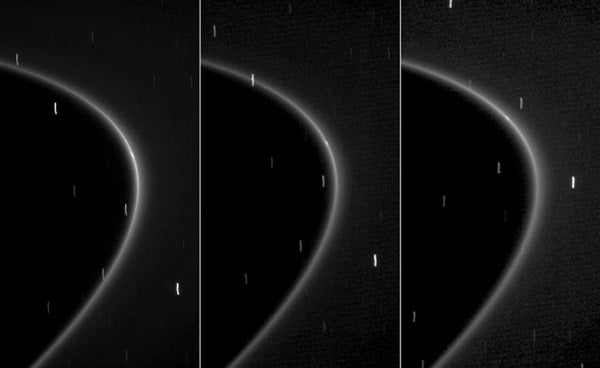In each image, a small streak of light within the ring is visible. Unlike the streaks in the background, which are distant stars smeared by the camera’s long exposure time of 46 seconds, this streak is aligned with the G ring and moves along the ring as expected for an object embedded in the ring.
Scientists interpret the moving streak to be reflected light from a tiny moon that is likely a major source of material in the arc and the rest of the G ring. Debris knocked off this moon forms a relatively bright arc of material near the inner edge of the G ring, the most visible part of the ring in these images. That arc, in turn, leaks material to form the entire ring.
An embedded moonlet appears as a faint, moving pinprick of light within Saturn’s G ring in images from NASA’s Cassini spacecraft. Scientists believe it is a main source of the G ring and its single ring arc.
Cassini scientists found the tiny moonlet while analyzing images acquired during a 600-day span. The object is about a third of a mile (half a kilometer) across, embedded within a partial ring, or ring arc.
“Before Cassini, the G ring was the only dusty ring that was not clearly associated with a known moon, which made it odd,” said Matthew Hedman, a Cassini imaging team associate at Cornell University in Ithaca, New York. “The discovery of this moonlet, together with other Cassini data, should help us make sense of this previously mysterious ring.”
Saturn’s rings were named in the order they were discovered. Working outward they are: D, C, B, A, F, G, and E. The G ring is one of the outer diffuse rings. Within the faint G ring, there is a relatively bright and narrow, 150-mile-wide (250-kilometer-wide) arc of ring material, which extends 90,000 miles (150,000 kilometers), or one-sixth of the way around the ring’s circumference. The moonlet moves within this ring arc. Previous Cassini plasma and dust measurements indicated that this partial ring might be produced from relatively large, icy particles embedded within the arc, such as this moonlet.
Scientists imaged the moonlet August 15, 2008, and then they confirmed its presence by finding it in two earlier images. They have since seen the moonlet on multiple occasions, most recently February 20, 2009. The moonlet is too small to be resolved by Cassini’s cameras, so its size cannot be measured directly. However, Cassini scientists estimated the moonlet’s size by comparing its brightness to another small Saturnian moon, Pallene.
Hedman and his collaborators also have found that the moonlet’s orbit is being disturbed by the larger, nearby moon Mimas, which is responsible for keeping the ring arc together.
This brings the number of Saturnian ring arcs with embedded moonlets found by Cassini to three. The new moonlet may not be alone in the G ring arc. Previous measurements with other Cassini instruments implied the existence of a population of particles, possibly ranging in size from about 3 to several hundred feet (1 to 100 meters) across. “Meteoroid impacts into, and collisions among, these bodies and the moonlet could liberate dust to form the arc,” said Hedman.
“The moon’s discovery and the disturbance of its trajectory by the neighboring moon Mimas highlight the close association between moons and rings that we see throughout the Saturn system,” said Carl Murray, a Cassini imaging team member and professor at Queen Mary, University of London. “Hopefully, in the future, we will learn more about how such arcs form and interact with their parent bodies.”
Early next year, Cassini’s camera will take a closer look at the arc and the moonlet. The Cassini Equinox mission, an extension of the original 4-year mission, is expected to continue until fall of 2010.










